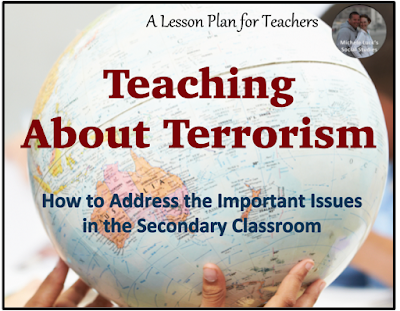As acts of terror continue to permeate our news, teachers are faced with the reality that we must address the issues in our secondary classrooms. Still, the many controversies, the chaos, and the complex fears create great challenges in developing that perfect lesson for our students.

Ideally, teachers could turn to ready-made resources to teach about the most recent acts of terrorism, but in my experience, that is NOT what is best for our students. Each classroom is unique in its personality and in the individual fears, anxieties, and needs of our students, calling for special attention to such personal matters.
That said, we must develop the lessons we know will help our students wrap their heads around the modern concerns and those that can help them identify paths to help remedy the problems of our world in the future. Here are a few suggestions to help you plan for this very important lesson:
- Be sure to address the many perspectives on the events involved. This is most important, and is the element that seems to be left out in many news reports that sensationalize horrific events over reporting the facts. Please teach without prejudice and allow your students to see the world as it is, and as it has always been:
- Terrorism is NOT related to religion. It is an act of extremism and cannot be generalized to include whole groups. The KKK claim they are Christian, but not all Christians are KKK. The same is true of those who practice other faiths and the extremist groups who claim those identities. It is important to remember that extremists and radicals are skilled at warping their chosen religious texts to meet their personal goals and to excuse their horrendous acts.
- We (speaking in political/national terms) are all guilty of terrorism. The U.S. has a long history of eliminating or restricting undesirables with injustices such as slavery or our movements to remove and rid our lands of Native American populations. Historically, most nations or political groups have excluded outsiders and have persecuted chosen populations at one time or another.
- What we see and “know” is based on where we are and our individual side on each event. We are very limited in our knowledge of other cultures and of personal feelings related to larger, more impersonal events. When sitting outside looking in, we cannot see the writing on the walls seen by those inside looking out. More importantly, we cannot feel the way those personally involved feel, and therefore, cannot comprehend their reactions to such events.
- Allow it to be personal. Students fear terrorism, and rightfully so. As a child of the Cold War, I was terrified that the president would push that big red button in his office, and the nuclear battle would begin, ending life as we all knew it. Those same fears are present today. Let your students voice them, treat them with respect, and be human enough to share your own anxieties. Then take it a step further.
- Discuss the future. Allow your students to brainstorm how they can be instrumental in making the future a different world than what we live in now. Don’t minimize suggestions and value all ideas, emphasizing the importance of every act, large and small.
- Reinforce the positive and the reality. The reality is simple – we do live in a world filled with acts of terror, both domestic and international. HOWEVER… The media makes these acts of terror seem larger and more widespread than they are in relation to the population of our world. The likelihood of terrorism on our own personal doorstep is slim. On the other hand, the randomness of (domestic) terror demands a call to action for today’s youth to bring the change needed to prevent such in the future.
- Make comparisons to other historic events. Watching the Syrian refugees cross borders sadly reminds me of Jews fleeing Nazi Germany or of Japanese being relocated to Internment Camps. They have given up everything except the things they carry to escape violence and hatred of those living around them. How did those historic events end? How could these modern ones evolve?
Teaching about Terrorism is not a choice for us anymore. It is more relevant to our students’ lives now than it has ever been in the past. More importantly, it is our students who may have a chance at bringing the change needed to shift our world toward a climate of empathy, understanding and acceptance rather than the climate of hatred, anger and exclusion that it is today.
*After your class lessons on current events. make those comparisons to the past with lessons that provide multiple perspectives and always encourage the application of empathy over anger. For ready made lessons on those historic events, take a look at my full Holocaust Unit or my 9/11 Response Group Activity.

Happy Teaching!